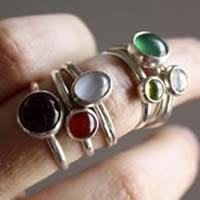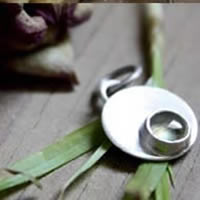- Jewelry
- Inspiration
- Good Deals
- Paintings
- About
- Contact
JEWELRY
- Anklet
- Bracelets
- Brooches
- Cufflinks
- Earrings
- Pendants & Necklaces
- Rings
- Draw your jewelry
- GOOD DEALS
- How to clean your jewel
- Metal we used
INSPIRATION
Onyx: history, healing properties and lithotherapy

Onyx properties

Originating from ancient Greek, the term "onyx" derives from "onux," which literally means "claw" or "nail." This name might reference the translucent appearance of certain specimens, whose flesh-toned hues resemble the texture and color of human nails.
A precious stone belonging to the chalcedony family, onyx is primarily composed of silicon. Its structure is characterized by distinct bands, often in black and white, although its shades can vary infinitely, excluding purple and blue.
On the Mohs scale, onyx has a hardness of 6.5 to 7, making it relatively resistant to scratches, though it remains softer than stones like sapphire or diamond. This moderate durability makes it suitable for everyday use in jewelry, while requiring some care to avoid heavy impacts or abrasions.
The density of onyx typically ranges between 2.6 and 2.7, which is common among chalcedonies. Its luster is described as vitreous to silky, contributing to its aesthetic appeal when polished. Additionally, its fracture is conchoidal, a characteristic shared by silica-rich stones, resulting in smooth, curved surfaces when broken.
The regularity of the colored bands in onyx has fascinated ancient civilizations, which utilized its qualities for artistic creations and valuable objects. This stone is particularly well-suited for carving and engraving, especially for the production of cameos and intaglios. Roman and Greek artisans excelled in these techniques, exploiting the layered structure to highlight intricate relief patterns.
Similarly, sardonyx, a specific variety of onyx, is distinguished by hues ranging from red to brown. This unique variety has also captured the interest of collectors and art enthusiasts for its distinctive beauty and diverse applications in jewelry and decorative items.
For centuries, dyeing techniques have been used to enhance the natural appearance of onyx. These processes typically involve chemical baths or heat treatments aimed at accentuating or altering its tones. Black onyx, in particular, is often achieved through artificial coloring to meet the demand for jewelry with a timeless and elegant appearance. While this practice is common, it occasionally sparks debates among natural stone enthusiasts regarding the authenticity of the stone in its modified form.
Today, onyx remains a versatile stone, used in both craftsmanship and decorative or architectural contexts. Its understated beauty and endless possibilities for enhancement continue to captivate across eras.
Mines: Brazil, Argentina, Mexico, the USA, Iran, Italy, Switzerland, Russia and India.
History, legends and beliefs about onyx
In ancient Egypt, the use of onyx dates back to the Second Dynasty, where skilled artisans carved bowls, vases, and other artifacts from this precious stone. Its presence in royal tombs highlights its symbolic significance and its association with the afterlife. Considered a noble material, onyx was valued not only for its aesthetic qualities but also for its perceived protective properties in funerary contexts.
During the Minoan era in Crete, sardonyx, a variety of onyx, was particularly prized for prestigious objects. In the opulent palaces of Knossos, it was used to create refined artworks and elaborate ornaments, often employed in religious or ceremonial settings. This stone symbolized power and wealth, reinforcing the status of the elite.
Among the Romans, onyx held a place of high esteem. Pliny the Elder, a renowned naturalist and author, meticulously described two primary varieties of onyx while documenting intricate techniques for its treatment and dyeing to meet the aesthetic demands of the time. These methods included impregnating the white bands with chemical solutions to enhance their color or transform them into a deep black.
A Roman legend, possibly inherited from Greek traditions, offers a mythical origin for onyx. In this tale, as Venus rested, her mischievous son Cupid cut her nails with an arrow. These divine fragments fell to Earth, where the gods, unable to let part of a goddess vanish, transformed them into eternal stones: onyx. This legend underscores the mysticism and beauty associated with onyx.
In biblical texts, onyx also appears as a sacred stone. It is among the twelve precious stones adorning the breastplate of the high priest Aaron, representing the twelve tribes of Israel. In the Book of Revelation, one of the gates of the heavenly Jerusalem is described as being made of onyx, symbolizing purity and eternity.
In Arab cultures, onyx, also known as "El Jaza" or "sadness," reflects a deep emotional connection. Often associated with feelings of melancholy, this stone was seen as a companion during times of mourning and inner reflection.

In Persia and India, onyx was revered for its protective powers. It was firmly believed to ward off the evil eye and negative energies. In these cultures, it was common to place onyx on the abdomen of women in labor to ease their pain, a practice linked to the stone’s soothing and stabilizing qualities. Additionally, onyx was regarded as a regulator of desires, often used by those seeking spiritual or emotional mastery.
In China, onyx carried a very different connotation. Viewed as an omen of misfortune, it was avoided by the local population, who preferred to export it to rid themselves of its presence. Onyx miners were often slaves or individuals forced into labor, as the stone was feared for its supposed ability to attract bad luck and harmful energies.
During the Victorian era in England, black onyx experienced an unprecedented resurgence in popularity. As a symbol of elegance and sobriety, it became a central element of mourning jewelry, which was highly fashionable during a period marked by strict mourning customs. Queen Victoria, who mourned for 40 years after the death of Prince Albert, popularized this trend, where black onyx embodied both the pain of loss and the elegance of tradition.
Healing properties and benefits of onyx
- Onyx is recognized for its stabilizing properties on the body. It works by restoring balance to bodily functions, contributing to overall harmony between the body and mind.
- By strengthening the bone marrow, bones, and feet, onyx provides a solid foundation and physical stability, helping to improve posture and prevent imbalances. This stone is particularly beneficial for those who need to "keep their feet on the ground."
- Its calming properties make it an ally for neurological disorders, such as epilepsy, by reducing nerve excitability.
- It can also play a role in soothing anxiety related to hypochondria, offering a comforting psychological support.
- Onyx is known for its beneficial effects on the liver and kidneys, promoting their proper function and aiding in the elimination of toxins.
- Onyx is reputed for its effectiveness in relieving conditions related to arthritis. Thanks to its soothing and regenerating properties, this precious stone helps reduce joint inflammation and alleviate chronic pain associated with the condition. By promoting better energy circulation in the body, onyx also helps strengthen joint mobility and preserve flexibility. When used in local massage with a polished stone or worn regularly, it provides natural support for those wishing to improve joint comfort.
- In lithotherapy, this stone is also recognized for its role in regulating blood lipids, indirectly helping to prevent cardiovascular diseases.
- Onyx is often associated with mental and emotional strength. It provides a sense of protection and resilience, helping individuals overcome emotional challenges and stay focused during difficult times.
Healing properties and benefits of the black onyx
- Black onyx is particularly valued for its protective qualities. It acts as an energetic shield, warding off negative influences and helping to maintain stable emotional balance.
- This stone is a precious support for individuals struggling with addictions. Its energy helps strengthen willpower, break cycles of dependency, and promote self-control.
- By boosting the immune system, black onyx helps reduce allergic reactions and alleviate associated symptoms, such as inflammation or itching.
- For pregnant women, black onyx is seen as a protective talisman. It encourages the harmonious development of the fetus and contributes to a peaceful pregnancy and childbirth by reducing fears and offering emotional support.
- Black onyx is closely associated with the root chakra (Muladhara). This chakra, located at the base of the spine, is the center of grounding and stability. By harmonizing this chakra, black onyx enhances inner security and helps one feel more rooted in reality.
Healing properties and benefits of the green onyx
- Green onyx is associated with vitality and regeneration. It is renowned for improving the health of hair, nails, and eyes, while also strengthening their resistance to external damage.
- Its soothing effect on the kidneys makes it an excellent choice for preventing kidney disorders or relieving associated pain.
- On an emotional level, green onyx acts as a natural calmative, reducing stress and promoting inner peace. It helps dispel negative thoughts and restore mental balance.
- Its healing properties extend to digestive issues, where it alleviates stomach pains and helps regulate intestinal functions.
- When applied or worn regularly, green onyx is recognized for its benefits to the skin, helping to treat skin infections and improve the texture of the epidermis.
- By stabilizing blood pressure, green onyx contributes to maintaining good cardiovascular health and helps prevent complications related to hypertension.
- Its use in treating ulcers highlights its powerful healing capabilities, promoting quick recovery and better tissue regeneration.
- Green onyx is also recognized for its benefits to nasal conditions and respiratory health. With its calming energy, it helps clear the airways, providing natural relief in case of congestion or infections.
- Its use in treating ulcers further demonstrates its strong healing properties and its potential to promote overall well-being.
- Green onyx is associated with the heart chakra (Anahata). It promotes emotional balance, openness to positive feelings, and healing of emotional wounds. This connection makes it an excellent choice for those looking to restore harmonious relationships or overcome emotional grief.
 Please note that all healing properties presented for gemstones are gathered from various sources. This information is provided as a service and is not intended to treat medical conditions. It is recommended to consult a healthcare professional for serious medical issues and not to rely solely on gemstones as a treatment.
Please note that all healing properties presented for gemstones are gathered from various sources. This information is provided as a service and is not intended to treat medical conditions. It is recommended to consult a healthcare professional for serious medical issues and not to rely solely on gemstones as a treatment.
Onyx jewelry samples
To learn more about litotherapy, we recommend you the following books:





















